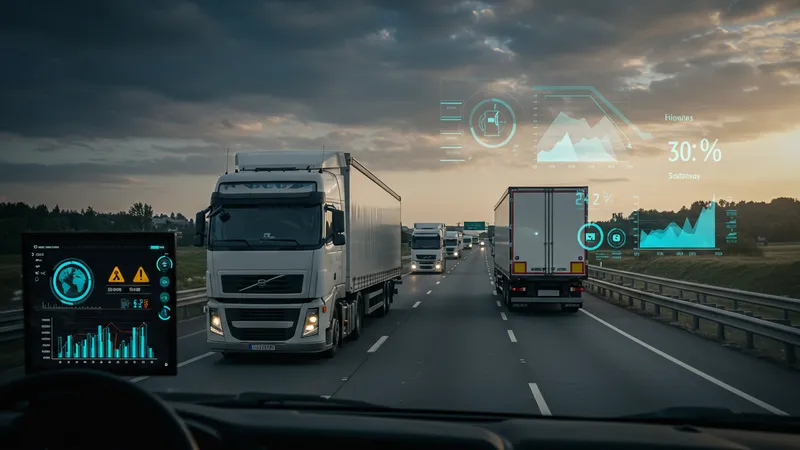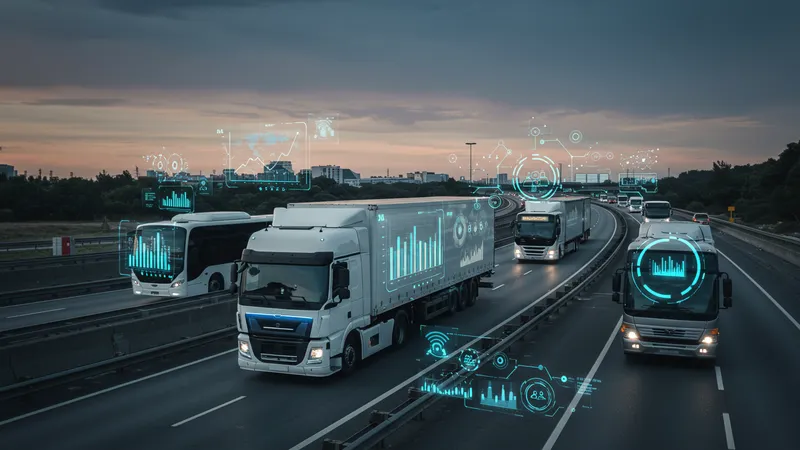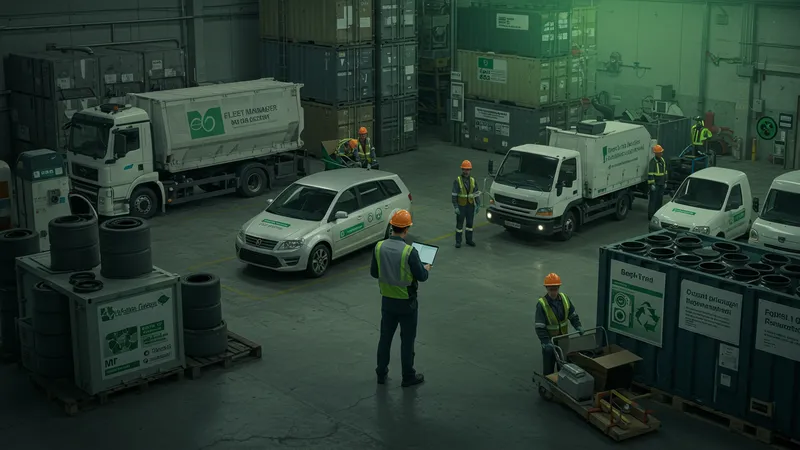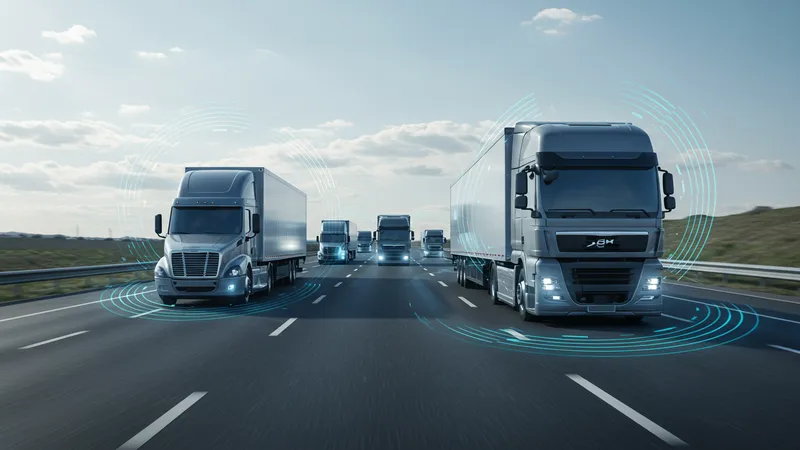Imagine discovering a method in fleet management that's said to slash fuel costs by 30% overnight. Could such a groundbreaking solution really exist, waiting to be unveiled?
As businesses grapple with skyrocketing transportation expenses, efficient fleet management is more crucial than ever before. With logistics costs soaring globally, this knowledge could be a financial lifesaver.

Fleet management isn't just about keeping trucks on the road. Recent studies have uncovered shocking inefficiencies in the way most companies handle their fleets, with the average business unknowingly gulping down thousands of dollars in surreptitious costs. But that’s not even the wildest part…
You’d be surprised to learn how emerging technologies, like AI and real-time data analytics, are quietly reshaping fleet logistics. These tools are enabling companies to not only predict maintenance needs but also streamline routes in ways experts never dreamed possible. The results? Astounding boosts in efficiency. But what happens next shocked even the experts…
Fuel costs drain the wallets of fleet managers globally. Yet, the secret to game-changing fuel efficiency could be found in the unlikeliest of places—driver behavior. Studies show that aggressive driving behaviors, such as rapid acceleration and hard braking, can significantly increase fuel consumption by as much as 40%. Imagine reducing your fuel costs by nearly half, just by adjusting driving habits.

Some companies have taken this a step further with technology monitoring systems that alert drivers in real-time about their driving habits. These systems provide instant feedback, allowing for immediate behavioral changes. Fleets employing such technologies have reported dramatic drops in fuel use, resulting in savings that make a real impact on their bottom line.
However, monitoring is only part of the equation. The integration of smart routing, leveraging machine learning algorithms that optimize routes by traffic conditions and vehicle load, has transformed how fleets operate. These insights often reveal substantial inefficiencies, leading to more reliable delivery times and reduced engine idle time.
But there’s one more twist—combining these approaches with electric and hybrid vehicles presents an entirely new frontier in efficiency. Pilots of these greener fleets have observed remarkable fuel cost reductions and lower emissions, but what you read next might change how you see this forever.
While traditional wisdom suggests sticking to a uniform fleet, blending different types of vehicles may unlock unexpected advantages. Take for instance, the strategic use of smaller vans for urban deliveries while reserving larger trucks for bulk order routes. This approach maximizes load efficiency and reduces congestion time, optimizing every trip.

The diverse vehicle strategy helps in asset management too. Different vehicle use results in varied wear and tear patterns, prolonging the lifespan of the fleet as a whole. Astonishingly, companies that have adopted mixed fleet strategies report a lifespan increase by up to 20% across several fleet components.
To manage this complexity, state-of-the-art telematics systems have become central. These systems provide real-time data on vehicle performance and maintenance needs, enabling fleet managers to head off problems before they become costly failures. This proactive approach reduces downtime, ensuring fleets are always ready for the next demand.
One might wonder whether the increased complexity of managing different vehicle types outweighs the benefits. However, new software solutions, such as integrated fleet management platforms, are making these challenges obsolete, streamlining operations like never before. But on the horizon is another shift that promises to be a game-changer for fleets.
Predictive maintenance is no longer a futuristic concept; it's a tangible reality transforming fleet management. By analyzing historical data and machine learning algorithms, AI predicts when a vehicle is likely to require maintenance before a breakdown occurs. This proactive approach is helping fleets avoid unexpected repair costs and unscheduled downtime, leading to significant productivity boosts.

Studies indicate that predictive maintenance can reduce maintenance costs by up to 25%, not to mention the ripple effects of less downtime on overall operational efficiency. Imagine your fleet almost never sitting idle due to unplanned maintenance needs—that's the power AI brings to fleet management.
Further, predictive maintenance ensures safety. By identifying potential mechanical issues before they become serious problems, fleets reduce the risk of accidents on the road. This not only ensures the welfare of the drivers but also enhances the reliability expected by clients for timely deliveries.
Yet, the full spectrum of AI in fleet management is far broader. From route optimization to fuel efficiency predictions, the integration of AI offers a holistic enhancement in fleet operations that traditional methods simply can't match. The disruption it brings doesn't stop at maintenance, as we'll explore in the following sections.
Regulatory compliance can be a nightmare for fleet managers, with the risk of non-compliance resulting in hefty fines and reputational damage. Despite this, many overlook the indirect costs that compliance incurs, such as the time and personnel required to track and meet these regulations.

The introduction of new electronic logging device (ELD) mandates has only increased the burden on fleets to keep accurate records. Notably, the implementation of automated compliance solutions can dramatically reduce the administrative load, allowing fleet staff to focus on core operations. These solutions ensure accurate logging and instant compliance reporting, which can save thousands annually.
Moreover, compliance extends beyond regulations to driver and vehicle safety standards. Interestingly, fleets that excel in meeting these standards often see a decrease in insurance premiums, as their track records afford them more favorable terms with insurance providers. This not only saves money but also positions fleets as more trustworthy partners.
But maintaining this delicate balance requires constant vigilance. As new regulations emerge, staying ahead means leveraging the latest in compliance technology and exploring collaborations with industry leaders to anticipate change. However, the true extent of innovation in this space might surprise you as you continue reading.
Deciding when to replace a vehicle in your fleet can be the difference between financial profitability and draining expenses. Yet, many companies either replace too soon, sacrificing newer vehicle benefits or too late, burdened by extensive repair costs.

The timing of vehicle replacement is critical and can impact operational costs massively. Depreciation calculators alongside maintenance logs can inform more strategic decisions in this area, allowing fleet managers to replace vehicles at the most cost-effective moment.
Furthermore, newer models typically offer better fuel efficiency and modern safety features, providing immediate financial and operational benefits upon replacement. This ensures continued fleet performance while minimizing risks associated with older, worn-out vehicles.
Interestingly, strategic alliances with vehicle manufacturers can also offer fleets the upper hand. These partnerships can lead to first access to new technology models and potential discounts that improve the overall fleet budget. But vehicle dynamics are merely one component; there's an emerging factor many aren't considering yet.
Driver training programs have quietly risen as one of the most powerful tools for enhancing fleet performance and efficiency. Companies investing in advanced driver training have documented an impressive reduction in accident rates, with some reporting a decline of up to 20% within the first year.

Improved driver skills translate directly to better fuel efficiency and lowered maintenance costs. With drivers equipped to handle vehicles more effectively, the longevity of the fleet increases, and the mundane wear and tear that often accumulates is significantly reduced.
The most successful programs don't merely focus on driving skills but embed drivers into a culture of safety and efficiency. Weekly seminars on new technologies, and nuanced tactics like eco-driving, ensure continual improvement and awareness among drivers.
Incentive programs bolstering these efforts further motivate drivers, rewarding those who consistently demonstrate safety and efficiency on the road. This holistic approach cultivates a virtuous cycle of improvements that ripple throughout the fleet's operations. Or so it seems, until you realize what's yet to be uncovered.
Drones are no longer confined to the realm of futuristic imaginations; they’re making their way into fleet logistics, offering innovative solutions for quick and efficient deliveries. Companies piloting drone deliveries report a near 50% reduction in delivery times for lightweight parcels, which is reshaping customer expectations and logistic models.

Beyond just delivery, drones are proving invaluable for freight and transport monitoring. They offer a bird's-eye view of traffic patterns and congestion, feeding data back to dispatch centers to reroute vehicles proactively and efficiently.
Though their integration faces regulatory challenges regarding airspace use, the pursuit of drones in logistics continues to garner industry support, suggesting a not-too-distant future where fleets and drones operate hand-in-hand for unparalleled efficiency.
This doesn’t just change logistics—it revolutionizes the possibilities of fleet management entirely, forcing businesses to rethink infrastructure and strategy. What’s coming next may redefine it all, leaving traditional models obsolete.
The modern fleet manager isn't just concerned with efficiency and cost—they’re also increasingly pressured to meet sustainability goals. Transitioning to hybrid or electric vehicles is just one part of the strategy. The true impact comes from a holistic approach encompassing efficient resource use across all fleet operations.

Recycling initiatives, such as oil and tire recycling, contribute significantly to lowering the carbon footprint. Companies adopting these practices have seen a remarkable 30% reduction in waste output, illustrating the powerful impact of sustainability under the lens of comprehensive environmental stewardship.
Moreover, partnerships with eco-friendly suppliers amplify these efforts, enabling access to sustainable materials and innovative solutions that further reduce ecological impacts. These collaborations drive both environmental and financial benefits, showcasing sustainability as a profitable pathway.
But sustainability doesn't solely derive from traditional efforts. New emerging technologies provide methods to enhance eco-friendly operations—or disrupt them altogether. Prepare to be startled by the next revelation as we delve deeper.
Often linked to cryptocurrencies, blockchain technology is making waves in fleet management for its ability to create transparent and secure transaction records. Using blockchain for logistics ensures secure tracking of cargo and fleet data, thus reducing fraud and enhancing trust between partners.

The immutable nature of blockchain records also facilitates easier dispute resolution across the supply chain, thereby lessening administrative burdens and improving efficiency. Imagine a world where delivery verifications are instant and undisputable.
Blockchain's decentralized nature can also provide fleets with real-time data on road taxes, tolls, and other fees, optimizing cost management and route planning. The transparency of blockchain transactions assures recipients and stakeholders of the veracity of information shared.
Blockchain's potential is vast yet largely untapped, but as adoption increases, its impact is on course to revolutionize logistics beyond recognition, providing new operational paradigms. An insight into the implication follows next.
Telematics has become the linchpin in data-driven fleet management strategies. With its ability to track and analyze vehicle data, telematics provides crucial insights into driver behavior, fuel consumption, route optimization, and vehicle maintenance.

Effective use of telematics data can lead to significant operational improvements, such as a 20% cut in fuel costs and improved route efficiency. This real-time data empowers fleet managers to make informed decisions swiftly, maximizing productivity and cost-effectivity.
Beyond the operational, telematics is increasingly critical for ensuring driver safety. Automated systems can alert drivers to potential risks and even intervene to prevent accidents, providing both peace of mind and enhanced safety records.
Telematics continues to evolve, incorporating new technologies and AI capabilities that bolster its utility further. The next advancements promise shifts nobody is quite prepared for, leading to unprecedented efficiency gains.
The flow of communication within fleets has historically been linear and slow. Today, digital tools are altering how fleets communicate, employing cutting-edge messaging systems and coordination platforms that ensure seamless information relay.

The deployment of instant messaging apps designed for fleet environments allow real-time communication between dispatch and drivers, reducing miscommunication and delays. Such tools enable immediate problem-solving and adaptive response to any situation on the road.
Moreover, video conferencing tools bring fleet teams together without the need for physical meetings, fostering better coordination, strategy development, and decision-making through virtual huddles that save time and resources.
These innovations mark a seismic shift in fleet operations, as understanding and implementing sophisticated communication solutions lead directly to better operational outputs. But there are unexpected effects that must be explored next.
As operational landscapes become more complex, continuous education in fleet management emerges as a catalyst for improved outcomes. Professional development programs train managers to stay ahead of technological trends, regulatory changes, and strategic management best practices.

Leaders armed with deeper insights make more informed decisions, capitalizing on new technologies and methodologies to enhance fleet efficiency. Companies investing in the education of their fleet managers have seen enhancement in performance metrics by double digits.
Moreover, industry conferences and workshops present networking opportunities that lead to valuable industry insights, fostering collaboration, and innovation. Exposure to groundbreaking ideas during these events often sees fleets adopting strategies that deliver transformative results.
Education may seem like a vague investment, but its impact on the operational efficacy of fleet management is profound, yet misleadingly subtle. Unraveling the potential next step in this journey, we discover more unexpected revelations.
Autonomous vehicles are no longer science fiction but a tangible future for fleet management. Pilot programs with self-driving trucks suggest reductions in overall transport costs by over 25%, thanks to continuous operation capabilities and efficiency of automated systems.

Though fully autonomous fleets are yet to become a reality, many vehicles already feature advanced driver-assistance systems (ADAS) that substantially enhance safety by detecting hazards and minimizing human error.
Experts predict a mixed fleet model, where semi-autonomous capabilities are initially integrated within traditional vehicles to navigate cities while full autonomy is trialed on less complex routes. This hybrid approach eases the transition into widespread autonomous fleet management.
The potential of this shift is staggering, with promises of improved safety records, drastic cost reductions, and unparalleled efficiency. Yet, the journey to full autonomy is fraught with challenges that demand exploration.
As we conclude this exploration of fleet management approaches, what stands out is the relentless march of innovation reshaping the landscape. The fuse of emerging technologies doesn't just provide efficiency but rewrites every rule known to fleet operations.
For professionals navigating this dynamic field, the time to act is now—absorb these insights, implement changes, and remain vigilant of the evolving future. The road ahead belongs to those willing to embrace and master the new paradigms of fleet management. Share this journey with your colleagues, bookmark it for future reference, and take action as tomorrow's fleet demands nothing less.